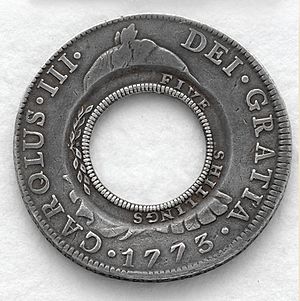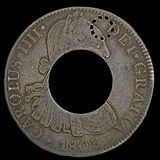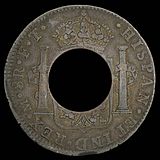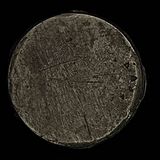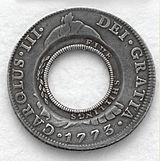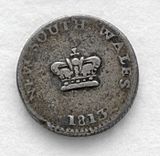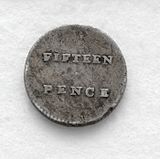Holey dollar facts for kids
The Holey dollar is a special type of coin used a long time ago in two British places: Prince Edward Island (which is now part of Canada) and New South Wales (which is now part of Australia). To make a Holey dollar, people punched out the middle of a Spanish dollar coin. This created two new coins: a small middle piece called a "dump" (in Australia) and the outer ring, which was the "holey dollar". This was one of the very first coins made specifically for use in Australia.
Contents
What is a Spanish Dollar?
Starting in 1497, the Spanish government made a big silver coin. This coin was used all over the world and became known as the Spanish dollar. People also called it the peso of eight reales, or Piece of eight royals.
Holey Dollars in Prince Edward Island
Around the late 1700s, the Spanish dollar was commonly used in Eastern Canada and the United States. Its value changed in different places. It was worth the most in Halifax. Because of this, merchants in Prince Edward Island (PEI) would send their Spanish dollars to Halifax to get more money for them.
This caused a shortage of coins in PEI. So, in 1813, the governor decided to collect all the Spanish dollars he could find. He then had their centers punched out. Both the middle plug and the outer ring were stamped with a sunburst design. The punched-out centers were used as shillings. The outer rings were used as five-shilling coins.
- Prince Edward Island Spanish Holey Dollar and punched centre – 1813
Holey Dollars in New South Wales, Australia
The Coin Shortage Problem
When the British colony of New South Wales was started in 1788, it had a big problem: not enough coins! People used coins from many different countries, like Britain, India, and Portugal. But these coins often left the colony when merchant ships visited for trade.
Because of this, people often had to trade things instead of using money. One popular item for trading was rum, which became like an unofficial currency. Governor King tried to set prices for foreign coins in 1800, but there still wasn't enough money. Governor Bligh later banned using rum as money in 1806. This even led to a big event called the Rum Rebellion.
Governor Macquarie's Solution
To fix the coin shortage, Governor Lachlan Macquarie came up with a clever idea. He used £10,000 worth of Spanish dollars that the British government had sent. These 40,000 Spanish dollars arrived in November 1812 on a ship called HMS Samarang.
The British government gave strict orders to keep these new coins from leaving the colony. So, Governor Macquarie talked with his officials. He then hired a man named William Henshall, who had been convicted of forgery. Henshall's job was to cut the centers out of the coins and stamp them. This made the coins useless outside of New South Wales.
Making the Holey Dollar and Dump
The small central piece, called a "dump," was given a new value of 15 pence. It was stamped with a crown on the front and its value on the back. The outer ring, the "holey dollar," was stamped around the hole with "New South Wales 1813" on the front and "Five Shillings" on the back.
These new stamps showed that the coins belonged to New South Wales. This made them the first official currency made specifically for the colony. Together, the holey dollar and the dump were worth 6 shillings and 3 pence (6s 3d) in New South Wales. This was 25 percent more than a regular Spanish dollar. This extra value made it not worth it for people to take the coins out of the colony.
Circulation and Rarity
It took over a year to convert all 40,000 Spanish dollars. In the end, 39,910 holey dollars and 39,910 dumps were made. The rest were likely damaged during the process. On July 1, 1813, Governor Macquarie announced that these new coins were legal money. They started being used in 1814.
From 1822, the government began to collect these coins back. They replaced them with British sterling coins. By 1829, when the holey dollar was officially stopped from being used, most of the 40,000 coins had been traded in and melted down. Experts believe that only about 350 holey dollars and 1500 dumps still exist today. Because they are so rare, even holey dollars that are not in perfect condition are very valuable. There are many interesting stories about how some of these rare coins have been found.
The Hannibal Head Holey Dollar
One of the most famous holey dollars is called the Hannibal Head. It's special because it's the only one that shows the face of King Joseph I of Spain. This coin was found in 1881 in Tasmania with other holey dollars. It's thought to have been part of a Bushranger's hidden treasure. In 2018, this unique coin was sold to a private collector for $500,000.
The holey dollar is also the logo for the Macquarie Group, an Australian investment bank.
- NSW Holey Dollar and dump in State Library of New South Wales collection
Other Similar Coins
The "holey dollar" idea was also used in other British colonies in the Caribbean. These places included British Guiana, Dominica, Grenada, Saint Vincent, Tobago, and Trinidad. They used the same method of punching holes in Spanish dollars to create new coins. These coins were valued in shillings and pence or in "bits."
Principality of Hutt River Coins
The Principality of Hutt River is a micronation in Australia. In 1977, they made a special $1 coin to celebrate Queen Elizabeth II's Silver Jubilee. In 1978, they made another $1 coin. These coins are also known as holey dollars by coin collectors, called numismatists.
See also
- Dominican dollar
- Grenadan dollar
- Saint Vincent dollar


